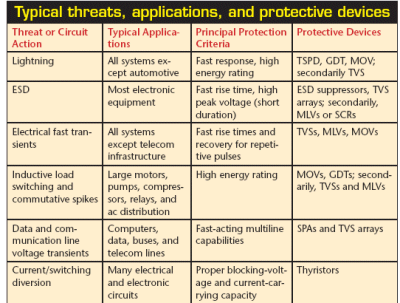It’s easy to prevent damage from transients if you know what is available for a particular application
BY KELLY CASEY
Littelfuse
Des Plaines, IL
http://www.littelfuse.com
Overvoltages, usually in the form of transients, can come from a variety of sources. Nearby lightning strikes, electrostatic discharges (ESDs) caused by people, and normal operation of electrical equipment can all create disruptive and potentially damaging transients.
Different threats demand different circuit protection devices. Designers of electronic circuits should first narrow their choice to one or two transient-voltage-suppression technologies that best fit the application in question.
Available technologies
There are multiple types of protective devices with different characteristics and applications. One useful rule of thumb is first to consider a technology that is similar to the technology of what is being protected. When protecting devices that are largely mechanical in nature such as switch gaps, wire, relays, the choice is likely to be ceramic components like gas-discharge tubes (GDTs) and metal-oxide varistors (MOVs).

When trying to protect devices that are made out of silicon and other high-sensitivity materials, the choice would tend to go toward the silicon protection line. Consider if you need a clamping device or a crowbar device. A clamp recovers when the transient goes away, but a crowbar keeps conducting until current drops below its holding value, and it generally shouldn’t be used on power circuits.
The basic idea is to construct a breakdown race between the circuit—or device to be protected—and the protector, and to make sure the protector will win every time. However, there’s no need to overpay for that protection.
There’s no need to buy silicon protection for relay contacts. Ceramic technologies like MOVs are less expensive than silicon devices; while they are less precise in action, this is not a problem in the applications for which they’re normally used.
GDTs
Also known as gas plasma arresters, gas-discharge tubes dissipate voltage transients through a contained plasma gas, handling surge currents up to 40,000 A. They have high insulation resistance plus low capacitance and leakage to ensure minimal effect on normal operation of telecom infrastructure equipment.
Their fast response and ability to dissipate large amounts of energy makes them a good choice for lightning surge protection, particularly for telecom equipment in outdoor structures. They are crowbar devices, so they cannot be used on power lines without fuses.
Varistors
Varistors divert transient voltage away from sensitive components. Their electrical behavior is similar to back-to-back silicon avalanche diodes.
Because they are clamping devices, they don’t short the line when they activate, and they recover automatically when the overvoltage is gone. There are two main varieties: MOVs and multilayer varistors (MLVs).
MLVs
MLVs provide protection of low to medium energy transients in sensitive equipment operating at 0 to 120 Vdc, with peak current ratings from 20 to 500 A, and peak energy ratings from 0.05 to 2.5 J. Typically used in automotive, computer, handheld device, and general industrial applications, they can provide enhanced performance and filtering characteristics at moderate cost.
Since MLVs are generally supplied as SMT devices, they do not suffer from significant parasitic inductance, and hence provide response times as low as 1 to 5 ns. Their comparatively large capacitance (which can reach 6,000 pF) means that they are not suitable for high-frequency lines.
MOVs
With energy ratings from 0.1 to 10,000 J and typical peak current ratings from 40 to 70,000 A, MOVs can divert transient currents away from sensitive circuit components in a wide range of applications.
The higher cost units at the upper end of this range are suitable for transient voltage suppression due to lightning and other high-level transients found in industrial and ac-line applications.
Polymeric ESD suppressors
Polymeric ESD suppressors are small fast-acting electrostatic discharge suppressors to protect electronics from transients. Their low-capacitance (0.05-pF) voltage-clamping ability makes them ideal for ESD suppression on high-speed digital I/O lines operating at 0 to 24 Vdc.
They are often chosen for high-speed circuits such as HDMI. Their capacitance is low enough to avoid causing unacceptable signal degradation. Surge energy rating is low.
Silicon protection arrays
These ESD-clamping devices are designed to protect analog and digital signal lines such as data lines, keypads, analog audio/video, HDMI, USB 2.0, and IEEE 1394. Since these are arrays of devices, they replace several discrete devices and result in real estate and placement cost savings.
Typical specifications include operating voltages up to 30 Vdc, leakage current as low as 20 nA, and capacitances as low as 3 pF. Like polymeric ESD suppressors, they have a low surge energy rating.
TVS diodes
Essentially power silicon avalanche diodes, transient voltage suppression (TVS) diodes are available in both unidirectional and bidirectional configurations. They provide protection against high-voltage transients in I/O interfaces, VCC bus, and other vulnerable circuits in telecom equipment, computers, industrial equipment, and consumer electronics.
Peak power ratings range from 400 W to 50 kW, and reverse standoff voltages from 5 to 376 V. Bidirectional TVS diodes are sometimes used on ac lines where their precision clamping voltages offer better consistency than MOVs. Due to their heavy construction and large junction areas, they have capacitances of up to 1,000 pF, meaning they are not typically suited for protecting high-speed lines.
Protection thyristors
Also known as bilateral voltage switches or thyristor surge protective devices (TSPDs), protection thyristors are designed to suppress overvoltage transients in telecom and datacom equipment. They can divert currents as high as 5,000 A to ground with minimal overshoot voltages.
Advantages of TSPDs include their low overshoot voltage, stable electrical characteristics, long term reliability, and low capacitance. Also, because TSPDs are crowbar devices, their on-state voltage is very low, which keeps power dissipation to a minimum. Because of this, extremely high surge current ratings are available in small packages. On the other hand, because they are crowbar devices, they must only be used in power-limited circuits. ■
For more on circuit protection, visit http://www2.electronicproducts.com/passive.aspx.
Advertisement
Learn more about Littelfuse





